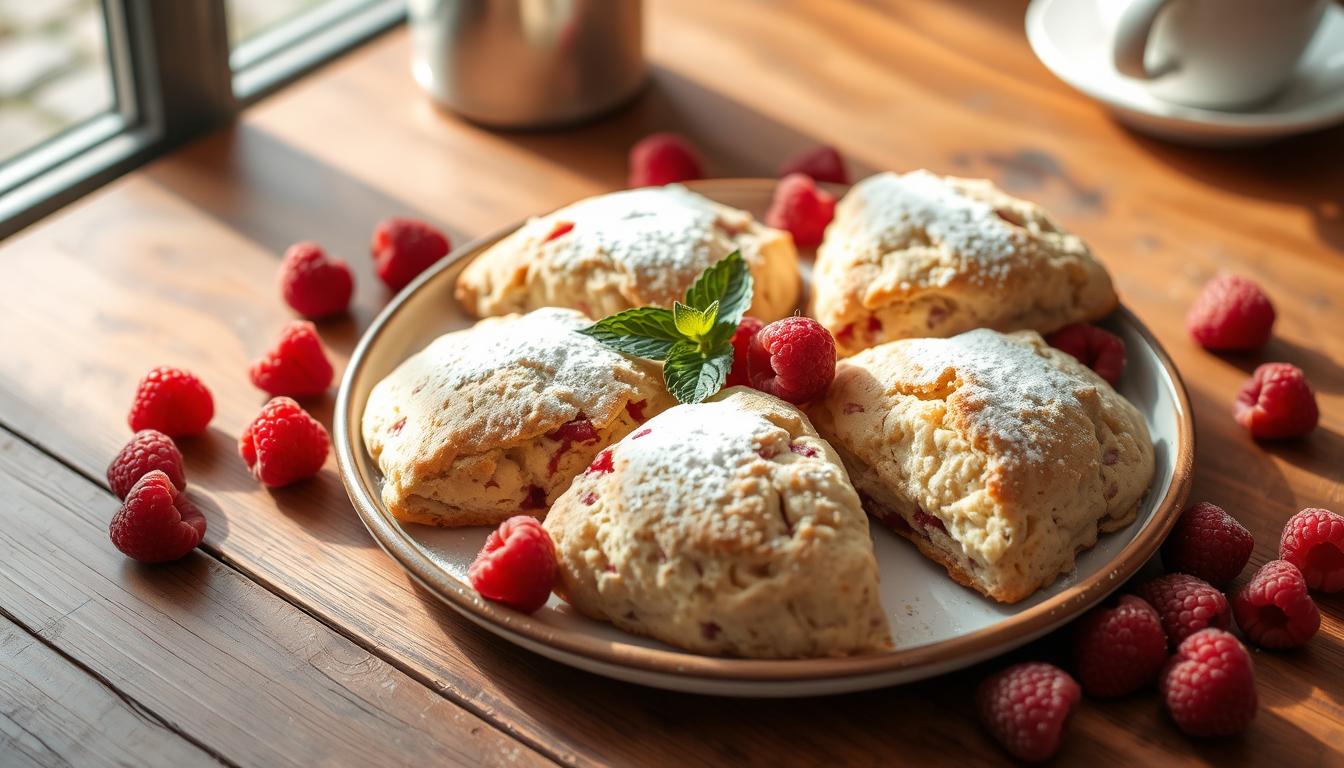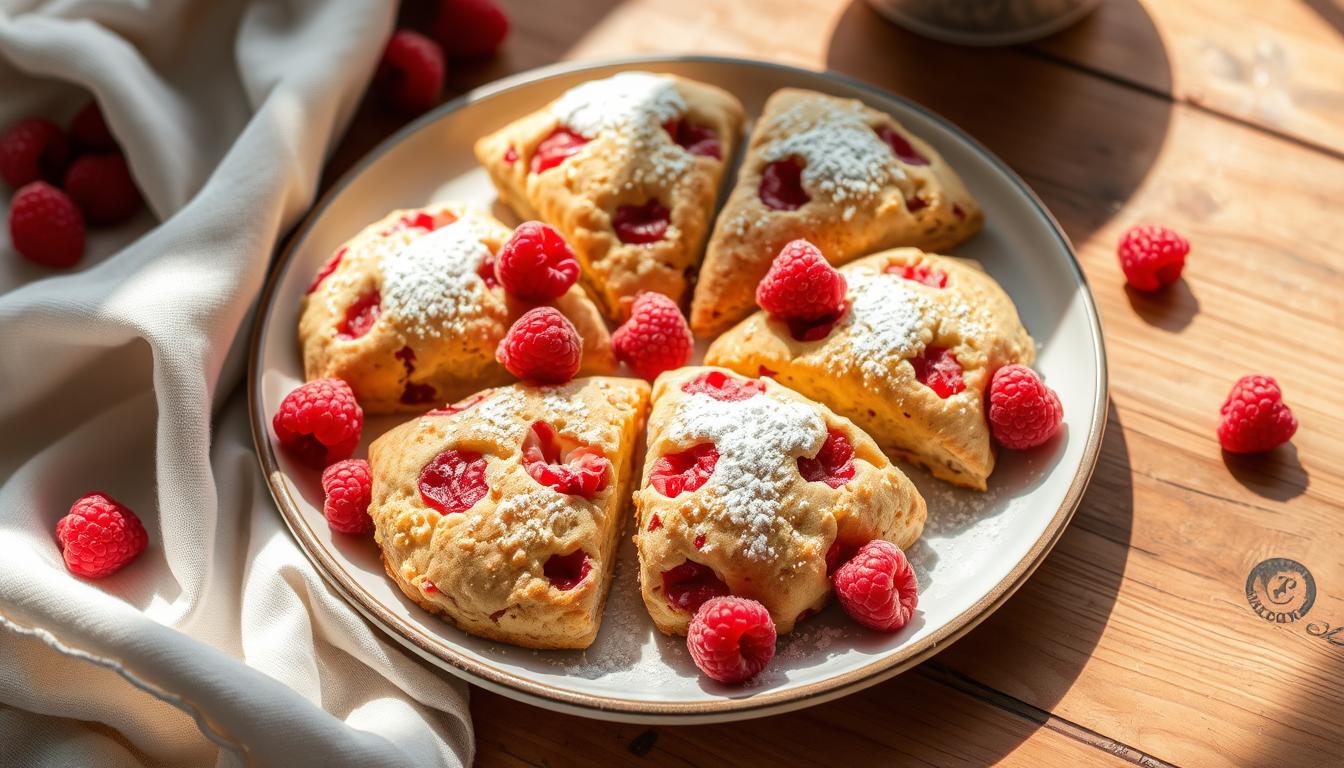Try the gluten-free raspberry and buttermilk scones for a tasty treat. They’re perfect for your 30-minute gluten-free recipe collection. These scones are both delicious and light, making them great for afternoon tea. You’ll get 6 large, fluffy scones from this recipe, and you can adjust the amount as needed.
The secret to their amazing texture is the buttermilk and bicarbonate of soda mix. This mix makes the scones bouncier and softer than regular ones. The buttermilk’s tangy taste balances out the raspberries’ sweetness, creating a wonderful flavor.
Key Takeaways
- Gluten-free raspberry and buttermilk scones offer a delightful afternoon tea treat
- The recipe yields 6 large scones with a slightly fluffy, bouncy texture
- Buttermilk provides a subtle tang that complements the sweetness of the raspberries
- The recipe can be easily halved or doubled to suit your needs
- Gluten-free baking can be achieved with the right ingredients and techniques
Understanding Gluten-free raspberry and buttermilk scones
Gluten-free raspberry and buttermilk scones are a special treat. They have a light, flaky outside and a moist inside. This is thanks to gluten-free flour and tangy buttermilk. These scones are perfect for anyone who needs to avoid gluten or just wants a tasty snack.
What Makes These Scones Special
The gluten-free flour makes these scones unique. It gives them a tender and flaky texture. This is great for those who can’t eat gluten. Plus, the fresh raspberries add a burst of flavor and color.
Benefits of Gluten-free Baking
Gluten-free baking is getting more popular. It’s great for people with celiac disease or gluten intolerance. It lets them enjoy baked goods without worrying about their health.
Why Buttermilk Matters in Scones
Buttermilk is key in these scones. It helps them rise quickly in the oven, making them light and fluffy. If you can’t find buttermilk, you can make a substitute with milk and lemon juice or vinegar. This way, you can still get the same texture.
“Gluten-free baking allows those with sensitivities to enjoy delicious treats without compromise.”
Essential Ingredients for Perfect Gluten-Free Scones
Making delicious gluten-free raspberry and buttermilk scones starts with picking the right ingredients. You’ll need a top-notch gluten-free flour blend, xanthan gum, and fresh raspberries. A gluten-free self-raising flour, like FREEE by Doves Farm or Bob’s Red Mill, is key. Xanthan gum is also crucial for binding and creating a flaky texture.
Along with the flour blend and xanthan gum, you’ll need baking powder, bicarbonate of soda, caster sugar, salt, unsalted butter, buttermilk, and eggs. You can also add mix-ins like chocolate chips, dried fruit, or chopped nuts to make it your own.
| Ingredient | Quantity |
|---|---|
| Gluten-free self-raising flour | 2 cups (296g) |
| Xanthan gum | 1 teaspoon |
| Baking powder | 2 teaspoons |
| Bicarbonate of soda | ½ teaspoon |
| Caster sugar | ½ cup (100g) |
| Salt | ¼ teaspoon |
| Unsalted butter, cold | ½ cup (113g) |
| Buttermilk | ½ cup (120ml) |
| Eggs | 1 |
| Fresh raspberries | ¾ cup (90g) |
Using a quality gluten-free flour blend with xanthan gum makes raspberry scones moist and flavorful. Be gentle when handling the dough and keep the butter cold for the best flaky texture.

The Secret to Working with Frozen Butter
Getting the perfect flaky texture in your gluten-free raspberry and buttermilk scones starts with frozen butter. Use frozen, finely grated butter to create air pockets. These pockets melt during baking, making your scones light and flaky.
Grating Technique for Optimal Results
To get the most out of your frozen butter, grate it finely. You can use a box grater or food processor. This ensures the butter is evenly distributed in your dough, enhancing the texture.
Temperature Control Tips
- Refrigerate the scone dough for 20-30 minutes before baking. This lets the butter firm up again.
- For an extra flaky boost, pop the shaped scones in the freezer for 15 minutes before baking.
- Keeping the butter cold is crucial. Work quickly and avoid handling the dough too much.
Why Cold Butter Creates Flaky Layers
As the frozen butter melts during baking, it releases steam. This creates air pockets, leading to flaky, buttery layers. This process is key to achieving the light, tender texture of perfect scones.
Mastering the art of working with frozen butter will help you bake impressive scones. Remember these techniques. Then, enjoy the rewards of your efforts – perfectly flaky, tender scones that melt in your mouth.
Step-by-Step Mixing and Preparation Method
Making gluten-free raspberry and buttermilk scones is a fun process. Start by getting your ingredients ready: gluten-free flour, baking powder, salt, frozen butter, fresh raspberries, buttermilk, and vanilla extract. This recipe makes 8 scones and takes less than an hour to prepare.
- In a big mixing bowl, mix together 2 cups of white whole wheat flour, 4 teaspoons of baking powder, 1/3 cup of granulated sugar, and 1/2 teaspoon of fine sea salt. Whisk until everything is well combined.
- Add the 6 tablespoons of frozen, grated unsalted butter to the dry mix. Use a pastry cutter or your fingers to mix the butter into the flour until it looks like coarse crumbs. Work fast to keep the butter cold.
- In another bowl, whisk together 2/3 cup of canned light coconut milk, 1 egg, and 1 teaspoon of vanilla extract.
- Slowly add the wet ingredients to the dry mix, being gentle not to overmix. Then, gently fold in the 3/4 cup of fresh raspberries, making sure not to crush them.
- Turn the dough onto a lightly floured surface and shape it into a 6-inch round, about 1-inch thick. Wrap it in plastic and chill in the fridge for 20-30 minutes. Then, freeze it for 15 minutes more.
- Preheat your oven to 400°F (205°C). Line a baking sheet with parchment paper.
- Take the chilled dough out of the freezer and cut it into 8 wedges. Place the wedges on the prepared baking sheet, leaving about 2 inches of space between each scone.
- Bake the scones for 20-23 minutes, or until they’re golden brown. Then, lower the oven temperature to 375°F (190°C) to help them bake evenly and get a crisp outside.
By following these steps, you’ll make a batch of gluten-free raspberry and buttermilk scones that are irresistible. Enjoy them for breakfast, afternoon tea, or at your next outdoor event.
Mastering the Perfect Scone Texture
Getting the right scone texture is about finding a balance. You want them to be flaky yet moist. Whether you’re making classic gluten-free raspberry and buttermilk scones or trying new flavors, these tips will guide you to success.
Avoiding Common Texture Problems
Gluten-free scones often turn out dry and crumbly. This can happen if you overwork the dough or if the ingredients aren’t balanced right. To avoid this, mix the dough gently and don’t add too much flour.
Achieving the Right Moisture Balance
Gluten-free dough tends to be stickier than regular dough. It’s key to find the right moisture level. The dough should be soft and slightly tacky but not too wet. Getting the right mix of wet and dry ingredients and chilling the dough before baking will help you get it just right.
Tips for Light and Flaky Results
- Use frozen grated butter for flakiness. The small pieces of butter create pockets of steam that result in tender, flaky layers.
- Handle the dough minimally to avoid overworking it. Gently pat or roll the dough into shape, rather than kneading it.
- Chill the dough before baking. This allows the gluten-free flour to fully hydrate, improving the texture.
By using these tips and techniques, you’ll be on your way to baking scones that are tender and flaky. Try out different gluten-free baking tips to find the perfect scone texture that you love.
Baking Tips and Temperature Guidelines
Baking gluten-free raspberry and buttermilk scones needs careful temperature control. Start by heating your oven to 500°F (260°C). Line a baking sheet with parchment paper or a silicone mat. This high temperature helps make a beautiful crust on the scones.
After placing the scones in the oven, lower the temperature to 425°F (218°C). Bake for 12-14 minutes. The scones should be golden brown and a toothpick inserted into the center should come out clean. This two-stage baking ensures the scones are cooked right and stay light and flaky.
For extra crunch, sprinkle a light dusting of sanding sugar on the scones before baking. The sugar will caramelize, adding a delightful crunch that goes well with the soft inside.
After baking, let the scones cool on a wire rack for 20 minutes before serving. This resting time helps set the structure and lets the flavors fully develop.
| Oven Temperature | Baking Time | Desired Texture |
|---|---|---|
| 500°F (260°C) initially, then reduced to 425°F (218°C) | 12-14 minutes | Golden-brown exterior, tender and flaky interior |
By following these baking temperature guidelines and tips, you can make perfectly baked gluten-free raspberry and buttermilk scones every time.
Storage and Make-Ahead Options
Enjoy the tasty flavors of your homemade gluten-free raspberry and buttermilk scones for longer. Learn how to store them properly. These flaky treats are best fresh, but you can keep them longer with a few tricks.
Freezing Instructions
For make-ahead baking, freeze the dough for up to 5 days before baking. Place the dough on a parchment-lined baking sheet and freeze until firm. Then, move them to an airtight container or freezer bag.
When you’re ready, bake the frozen scones straight from the freezer. They might need a few extra minutes in the oven.
You can also freeze baked scones for up to 3 months. Cool them down first, then wrap each one in plastic wrap. Store them in a freezer bag. To reheat, bake them in a 350°F oven for about 10 minutes.
Shelf Life Recommendations
For room temperature storage, keep baked scones in an airtight container for up to two days. For longer storage, refrigerate them for up to 5 days. Reheat them in the oven or microwave for a fresh taste.
With these simple freezing scones and storage tips, enjoy your homemade gluten-free raspberry and buttermilk scones anytime.
Serving Suggestions and Variations
Gluten-free raspberry and buttermilk scones are perfect for many occasions. Enjoy them with jam and clotted cream for a true British cream tea. Try adding chocolate chips, berries, nuts, or dried fruits for new flavor variations.
For a zesty twist, add lemon zest and top with lemon glaze. For a savory option, cut down on sugar and skip the vanilla. These scones are great with coffee or tea, perfect for afternoon tea treats or a tasty breakfast.
| Nutrition Facts | Per Serving |
|---|---|
| Calories | 178kcal |
| Carbohydrates | 26g |
| Protein | 4g |
| Fat | 6g |
| Saturated Fat | 4g |
| Polyunsaturated Fat | 0.4g |
| Monounsaturated Fat | 2g |
| Trans Fat | 0.2g |
| Cholesterol | 17mg |
| Sodium | 140mg |
| Potassium | 173mg |
| Fiber | 1g |
| Sugar | 5g |
| Calcium | 84mg |
| Iron | 1mg |
Gluten-free raspberry and buttermilk scones are great for many occasions. Enjoy them with jam and clotted cream for a classic British cream tea. Or, try new flavor variations and scone toppings. They’re perfect for afternoon tea treats any time.
Conclusion
Gluten-free raspberry and buttermilk scones are a tasty treat for those who can’t have gluten. They taste and feel like regular scones, thanks to the right ingredients and techniques. You can also mix and match flavors to fit your diet.
These scones are perfect for any occasion or a cozy day at home. Making homemade scones is a fun and rewarding process. They’re great with tea or at brunch, making any meal special.
To make these scones, you need to know about the right ingredients, how to mix them, and keeping the right temperature. With a bit of practice, you’ll make scones that everyone will love. Enjoy the process and the delicious taste of these special scones.


